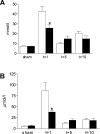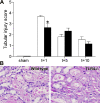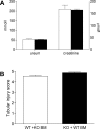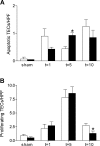Toll-like receptor-4 coordinates the innate immune response of the kidney to renal ischemia/reperfusion injury
- PMID: 18974879
- PMCID: PMC2570789
- DOI: 10.1371/journal.pone.0003596
Toll-like receptor-4 coordinates the innate immune response of the kidney to renal ischemia/reperfusion injury
Abstract
Toll-like receptors (TLRs) can detect endogenous danger molecules released upon tissue injury resulting in the induction of a proinflammatory response. One of the TLR family members, TLR4, is constitutively expressed at RNA level on renal epithelium and this expression is enhanced upon renal ischemia/reperfusion (I/R) injury. The functional relevance of this organ-specific upregulation remains however unknown. We therefore investigated the specific role of TLR4 and the relative contribution of its two downstream signaling cascades, the MyD88-dependent and TRIF-dependent cascades in renal damage by using TLR4-/-, MyD88-/- and TRIF-mutant mice that were subjected to renal ischemia/reperfusion injury. Our results show that TLR4 initiates an exaggerated proinflammatory response upon I/R injury, as reflected by lower levels of chemokines and infiltrating granulocytes, less renal damage and a more preserved renal function in TLR4-/- mice as compared to wild type mice. In vitro studies demonstrate that renal tubular epithelial cells can coordinate an immune response to ischemic injury in a TLR4-dependent manner. In vivo we found that epithelial- and leukocyte-associated functional TLR4 contribute in a similar proportion to renal dysfunction and injury as assessed by bone marrow chimeric mice. Surprisingly, no significant differences were found in renal function and inflammation in MyD88-/- and TRIF-mutant mice compared with their wild types, suggesting that selective targeting of TLR4 directly may be more effective for the development of therapeutic tools to prevent I/R injury than targeting the intracellular pathways used by TLR4. In conclusion, we identified TLR4 as a cellular sentinel for acute renal damage that subsequently controls the induction of an innate immune response.
Conflict of interest statement
Figures








Similar articles
-
TLR4 activation mediates kidney ischemia/reperfusion injury.J Clin Invest. 2007 Oct;117(10):2847-59. doi: 10.1172/JCI31008. J Clin Invest. 2007. PMID: 17853945 Free PMC article.
-
The effect of PACAP38 on MyD88-mediated signal transduction in ischemia-/hypoxia-induced acute kidney injury.Am J Nephrol. 2010;32(6):522-32. doi: 10.1159/000321491. Epub 2010 Oct 28. Am J Nephrol. 2010. PMID: 20980738
-
Recipient Toll-like receptors contribute to chronic graft dysfunction by both MyD88- and TRIF-dependent signaling.Dis Model Mech. 2010 Jan-Feb;3(1-2):92-103. doi: 10.1242/dmm.003533. Epub 2009 Dec 28. Dis Model Mech. 2010. PMID: 20038715
-
Contribution of renal tubule epithelial cells in the innate immune response during renal bacterial infections and ischemia-reperfusion injury.Chang Gung Med J. 2010 May-Jun;33(3):225-40. Chang Gung Med J. 2010. PMID: 20584500 Review.
-
Role of Toll-like receptor-4 in renal graft ischemia-reperfusion injury.Am J Physiol Renal Physiol. 2014 Apr 15;306(8):F801-11. doi: 10.1152/ajprenal.00469.2013. Epub 2014 Feb 12. Am J Physiol Renal Physiol. 2014. PMID: 24523386 Free PMC article. Review.
Cited by
-
KIM-1-mediated phagocytosis reduces acute injury to the kidney.J Clin Invest. 2015 Apr;125(4):1620-36. doi: 10.1172/JCI75417. Epub 2015 Mar 9. J Clin Invest. 2015. PMID: 25751064 Free PMC article.
-
Alveolar macrophages and Toll-like receptor 4 mediate ventilated lung ischemia reperfusion injury in mice.Anesthesiology. 2012 Oct;117(4):822-35. doi: 10.1097/ALN.0b013e31826a4ae3. Anesthesiology. 2012. PMID: 22890118 Free PMC article.
-
Reverse signaling through the costimulatory ligand CD137L in epithelial cells is essential for natural killer cell-mediated acute tissue inflammation.Proc Natl Acad Sci U S A. 2012 Jan 3;109(1):E13-22. doi: 10.1073/pnas.1112256109. Epub 2011 Dec 12. Proc Natl Acad Sci U S A. 2012. PMID: 22160719 Free PMC article.
-
Transcriptional analysis of infiltrating T cells in kidney ischemia-reperfusion injury reveals a pathophysiological role for CCR5.Am J Physiol Renal Physiol. 2012 Mar 15;302(6):F762-73. doi: 10.1152/ajprenal.00335.2011. Epub 2011 Dec 7. Am J Physiol Renal Physiol. 2012. PMID: 22160774 Free PMC article.
-
Toll-like receptor 4 regulates early endothelial activation during ischemic acute kidney injury.Kidney Int. 2011 Feb;79(3):288-99. doi: 10.1038/ki.2010.381. Epub 2010 Oct 6. Kidney Int. 2011. PMID: 20927041 Free PMC article.
References
-
- Daha MR, van Kooten C. Is the proximal tubular cell a proinflammatory cell? Nephrol Dial Transplant. 2000;15(Suppl 6):41–43. - PubMed
-
- West AP, Koblansky AA, Ghosh S. Recognition and signaling by toll-like receptors. Annu Rev Cell Dev Biol. 2006;22:409–437. - PubMed
-
- Johnson GB, Brunn GJ, Platt JL. Activation of mammalian Toll-like receptors by endogenous agonists. Crit Rev Immunol. 2003;23:15–44. - PubMed
-
- Schnare M, Rollinghoff M, Qureshi S. Toll-like receptors: sentinels of host defence against bacterial infection. Int Arch Allergy Immunol. 2006;139:75–85. - PubMed
Publication types
MeSH terms
Substances
LinkOut - more resources
Full Text Sources
Other Literature Sources
Medical
Molecular Biology Databases

